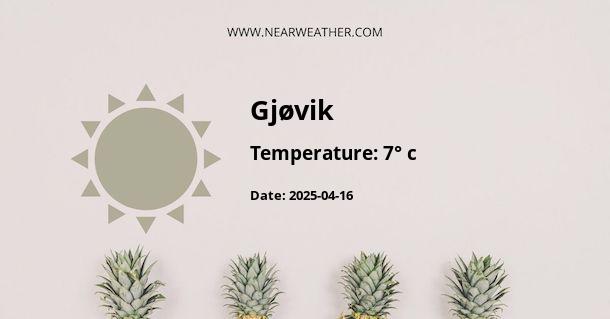Gjøvik, Norway: A Comprehensive Guide to Its Climate and Weather Year Round
Gjøvik, a scenic city located in Norway, is renowned for its natural beauty and captivating weather patterns. Understanding the climate and weather variations in Gjøvik is essential for residents, tourists, and business owners alike. This comprehensive guide provides insights into Gjøvik's climate and weather year round, allowing individuals to gain an in-depth understanding of what to expect when visiting or residing in this picturesque location.
Seasonal Weather Overview
Gjøvik experiences distinct seasonal variations, each offering unique weather patterns and atmospheric conditions.
Spring (March to May)
During spring, Gjøvik emerges from its winter slumber, with nature coming alive as temperatures gradually rise. The days become longer, providing ample sunlight for outdoor activities and exploration. However, spring in Gjøvik can still be quite chilly, with occasional snowfall in March and early April.
Summer (June to August)
Summer in Gjøvik is a time of vibrant greenery, blossoming flowers, and extended daylight hours. The weather is generally mild and pleasant, with average temperatures ranging from 15°C to 20°C. This makes it an ideal time for hiking, boating, and enjoying the numerous outdoor attractions around Lake Mjøsa, the largest lake in Norway.
Autumn (September to November)
As autumn sets in, Gjøvik's landscape transforms into a mesmerizing tapestry of red, orange, and golden hues. The weather gradually cools down, and the city experiences an array of weather conditions, from crisp sunny days to misty mornings and occasional rainfall.
Winter (December to February)
Winter in Gjøvik blankets the city in snow, creating a picturesque winter wonderland. The temperatures typically range from -3°C to -10°C, with occasional dips to even lower values. This season provides opportunities for winter sports enthusiasts to indulge in activities such as skiing, snowboarding, and ice skating.
Average Monthly Weather Data
To gain a deeper understanding of Gjøvik's climate, let's explore the average monthly weather data for temperature and precipitation.
| Month | Mean Temperature (°C) | Precipitation (mm) |
|---|---|---|
| January | -5 | 40 |
| February | -4 | 30 |
| March | 0 | 35 |
| April | 5 | 40 |
| May | 11 | 50 |
| June | 15 | 65 |
| July | 17 | 80 |
| August | 16 | 90 |
| September | 11 | 75 |
| October | 6 | 60 |
| November | 0 | 50 |
| December | -3 | 45 |
The average temperature and precipitation data provides valuable insights into the climatic conditions that individuals can expect each month in Gjøvik. It is evident that the city experiences a wide range of temperatures and precipitation levels throughout the year, highlighting the dynamic nature of its climate.
Weather-Related Activities and Attractions
Regardless of the season, Gjøvik offers a plethora of activities and attractions that are influenced by its unique climate and weather patterns.
Winter Sports
During the winter months, Gjøvik's snow-covered landscape sets the stage for exhilarating outdoor activities. The city is a haven for winter sports enthusiasts, offering opportunities for skiing, snowboarding, and snowshoeing in the surrounding mountains and ski resorts.
Lake Mjøsa
As the largest lake in Norway, Lake Mjøsa serves as a focal point for various water-based activities during the warmer months. Visitors can partake in boating, fishing, and lakeside picnics while taking in the breathtaking natural scenery that surrounds the lake.
Outdoor Festivals and Events
Gjøvik's climate plays a significant role in shaping its cultural events and festivals. From summer music festivals and outdoor markets to winter celebrations and holiday gatherings, the city's weather influences the timing and nature of these vibrant occasions.
Climate Resilience and Adaptation
Gjøvik, like many regions, is not immune to the impacts of climate change. As such, the city has been actively investing in climate resilience and adaptation measures to mitigate potential risks and build a sustainable future.
"With a changing climate, it is crucial for Gjøvik to prioritize adaptation strategies that address evolving weather patterns and their potential impact on the city's infrastructure, economy, and natural resources." - Dr. Anders Børresen, Climate Scientist
The city's efforts to adapt to its changing climate include sustainable urban planning, flood management systems, and initiatives to reduce greenhouse gas emissions. These proactive measures reflect Gjøvik's commitment to safeguarding its environment and communities in the face of changing weather patterns.
Conclusion
Gjøvik's climate and weather year round encompass a diverse spectrum of seasonal characteristics, from the tranquility of summer to the enchantment of winter. Understanding these weather patterns is integral for residents, visitors, and authorities as they navigate the city's natural environment and plan for its sustainable future. By appreciating the nuances of Gjøvik's climate, individuals can fully embrace the distinct charm and resilience of this Norwegian gem.
A - Gjøvik's Latitude is 60.794720 & Longitude is 10.692870.
A - Weather in Gjøvik is 7° today.
A - Climate Conditions in Gjøvik shows moderate rain today.
A - Humidity in Gjøvik is 86% today.
A - Wind speed in Gjøvik is 3.96 km/h, flowing at 45° wind direction. today.
